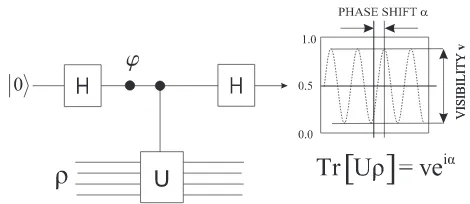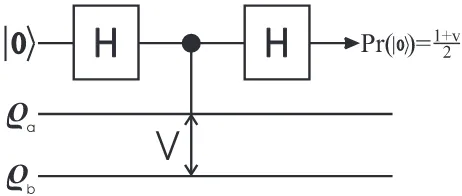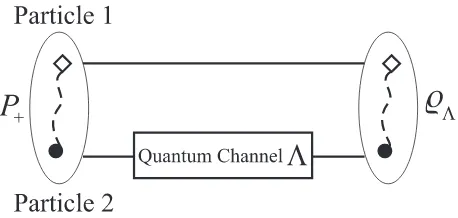Kwek, L C and Choo, K W and Du, J F and Ekert, A K and Alves, C M and
Horodecki, M and Horodecki, P and Kaszlikowski, D and Nazimudeen, N
and Oh, C H and Oi, D K L (2005) A universal quantum estimator.
International Journal of Quantum Information, 3. pp. 123-132. ,
http://dx.doi.org/10.1142/9789812701633_0011
This version is available at
https://strathprints.strath.ac.uk/35330/
Strathprints is designed to allow users to access the research output of the University of Strathclyde. Unless otherwise explicitly stated on the manuscript, Copyright © and Moral Rights for the papers on this site are retained by the individual authors and/or other copyright owners. Please check the manuscript for details of any other licences that may have been applied. You may not engage in further distribution of the material for any profitmaking activities or any commercial gain. You may freely distribute both the url (https://strathprints.strath.ac.uk/) and the content of this paper for research or private study, educational, or not-for-profit purposes without prior permission or charge.
Any correspondence concerning this service should be sent to the Strathprints administrator:
strathprints@strath.ac.uk
The Strathprints institutional repository (https://strathprints.strath.ac.uk) is a digital archive of University of Strathclyde research outputs. It has been developed to disseminate open access research outputs, expose data about those outputs, and enable the
arXiv:quant-ph/0112073v1 12 Dec 2001
Universal Quantum Estimator
Artur K. Ekert, Carolina Moura Alves,∗ and Daniel K. L. Oi
Centre for Quantum Computation, Clarendon Laboratory, University of Oxford, Parks Road, Oxford OX1 3PU, U.K.
Micha l Horodecki
Institute of Theoretical Physics and Astrophysics, University of Gda´nsk, 80-952 Gda´nsk, Poland.
Pawe l Horodecki
Faculty of Applied Physics and Mathematics, Technical University of Gda´nsk, 80-952 Gda´nsk, Poland.
L. C. Kwek
Department of Natural Sciences, National Institute of Education, Nanyang Technological University, 1 Nanyang Walk, Singapore 637616
(Dated: February 1, 2008)
We present a simple device based on the controlled-SWAP gate that performs quantum state tomography. It can also be used to determine maximum and minimum eigenvalues, expectation values of arbitrary observables, purity estimation as well as characterizing quantum channels. The advantage of this scheme is that the architecture is fixed and the task performed is determined by the input data.
PACS numbers: 03.67.Hk, 03.67.Lx
One of the the key issues in quantum information is, given an unknown quantum system, what can we learn about it. In particular, we are concerned not only with the resources needed (number of identical unknown phys-ical systems), but also with the complexity of quantum operations required (number of different devices, net-works, etc.), in order to obtain certain information about
a quantum state, characterized by its density matrix ̺.
There are many interesting parameters of̺we can
deter-mine, such as its maximum and minimum eigenvalues, its
purity or even̺itself (state tomography [1]), but we also
can use̺to determine expectation values of arbitrary
ob-servables or to characterize unknown quantum channels. However, this usually involves building separate devices for each task, or even building different devices for dif-ferent measurements within the same task.
In this paper we present a simple, universal device, whose architecture is fixed but whose behaviour is de-termined by the choice of input data [2] (see also [3] for a quantum optical realization of a similar idea). In fact, with suitable input, we can directly measure all the prop-erties mentioned before.
Consider a typical interferometric set-up for a single
qubit: Hadamard gate, phase shift ϕ, Hadamard gate,
followed by a measurement in the computational basis. Here and in the following, we borrow terminology from quantum information science and describe quantum in-terferometry in terms of quantum logic gates [4]. We
modify the interferometer by inserting a controlled-U
op-eration between the Hadamard gates, with its control on
the qubit and with U acting on a quantum system
de-scribed by some unknown density operator ρ. We do
FIG. 1: Both the visibility and the shift of the interfer-ence patterns of a single qubit (top line) are affected by the controlled-U operation.
not assume anything about the form of ρ, it can, for
example, describe several entangled or separable sub-systems. This set-up is shown in Fig. 1. The action of
the controlled-U on ρ modifies the interference pattern
by the factor,
TrρU = veiα, (1)
where v is the new visibility and α is the shift of the
interference fringes, also known as the Pancharatnam phase [5].
Thus, the observed visibility gives a straightforward way of estimating the average value of unitary operators
U in stateρand has a variety of interesting applications.
For example, it can be used to measure some
entangle-ment witnessesW, as long as they are unitary operators
and the corresponding controlled-W operations are easy
to implement [6]. Here, we focus on the applications related to quantum state state tomography. Clearly the
[image:2.612.321.556.330.432.2]2
density matrixρby a judicious choice of d2−1 unitary
operators U (the basis). However, this requires
build-ing d2−1 networks, each with a different U. We will
show that one can build a universal state estimator i.e. a
simple quantum device with afixed architecture, where
the state estimation is performed by modifyingonly the
input data.
In order to do this, let ρto be composed of two
sub-systems of dimension d, ρ = ̺a ⊗̺b. We will fix our
controlled-U to be the controlled-V (SWAP) operator,
such that V
α β = β α
for any pure states of the subsystems (Fig. 2). Let us also introduce the
maxi-mally entangled state
φ+ = 1/
√ dP i i i and let
P+ = φ+hφ+|. In this case, the modification of the
interference pattern given by (1) can be written as,
v = TrV(̺a⊗̺b) = Tr̺a̺b. (2)
Since Tr̺a̺b is real, we can fixϕ= 0 and the probability
of measuring the qubit to be in the state
0
at the output is related to the visibility by,
v = 2 Pr 0
−1. (3)
If ρ is not separable then, writingV = PTb
+ , we obtain
TrV ρ= TrρTbP
+ (the average value of partially
trans-posedρin the maximally entangled stateP+).
Now, let̺bbe an unknownd×ddensity operator. Such
an operator is determined by d2−1 real parameters. In
order to estimate matrix elements of̺b in a prescribed
orthonormal basis,
n , we proceed as follows: We run
the interferometer as many times as possible (limited by
the number of copies of̺b at our disposal) on the input
ψ
hψ| ⊗̺b, where
ψ
is a pure state of our choice. For
a fixed
ψ
, after several runs we obtain an estimation of,
v =hψ|̺b
ψ
. (4)
The diagonal elements hn|̺b
n
can be determined
us-ing the input states
n
hn| ⊗̺b. The real part of the
off-diagonal elementhn|̺b
k
can be estimated by
choos-ing ψ = ( n + k
)/√2, and the imaginary part by
choosing ψ = ( n +i k
)/√2. In particular, if we
want to estimate the density operator of a qubit, we can
choose the pure states,
0
(spin +z),
0
+
1
/√2
(spin +x) and
0
+i
1
/√2 (spin +y).
We can extend the procedure above to estimate expec-tation values of arbitrary observables. It can be shown that the mean value of an arbitrary observable can be reduced to the estimation of a binary two-output POVM
[7]. Similarly, the mean valuehAi̺b of an arbitrary
ob-servable A in state̺b can be measured using the setup
in Fig. 2 with a suitable input ̺a. We shall apply the
technique utilized in Refs. [8, 9]. AsA′=γ
I
+Ais [image:3.612.323.554.50.148.2]pos-itive if −γ is the minimum negative eigenvalue ofA, we
FIG. 2: Universal Quantum Estimator. By judicious choice of input̺a, the state of̺bcan be determined by examining the change in the visibility observed.
can construct the state̺a =̺A′ = A
′
Tr(A′) and apply our
interference scheme to the pair ̺A′⊗̺b. The visibility
gives us the mean value of V (SWAP),
v =hVi̺A′⊗̺b= Tr (̺A′̺b), (5)
which leads us to the desired value,
hAi̺b≡Tr (̺bA) = vTrA+γ(vd−1), (6)
where Tr
I
=d.Other quantities related to̺b may be determined by
simple modification of the interferometry scheme. If we
have at our disposal two copies of̺b per run, by running
the interferometer on the input,ρ=̺b⊗̺b, the resulting,
v = Tr̺2b =
X
i
λ2i, (7)
where{λi}are the eigenvalues of̺b, gives us an estimate
of the purity of ̺b. In the single qubit case, this
mea-surement allows us to estimate various functionals of̺b,
such as the length of the Bloch vector,
|r|=√2v−1. (8) Note that the direction, however, is left completely
undetermined. The procedure of estimating
eigenval-ues and non-linear functionals of ̺b can be generalized
for larger dimensional systems, but requires controlled-SHIFT gates [8].
By adapting the input to the interferometer, we can also estimate the extremal eigenvalues and eigenvectors
of̺b. In this case, the input states are also of the form
ψ
hψ|⊗̺bbut we vary
ψ
and search for the minimum
and the maximum of v = hψ|̺b
ψ
. This is usually a
complicated task as it involves scanning 2(d−1)
param-eters ofψ. The visibility is related to the overlap of the
reference state,
ψ
and̺b by,
vψ = Tr
ψ
hψ|X i
λi
ηihηi|
!
= X
i
λi|hψ|ηii|2=
X
i
where P
ipi = 1. This is a convex sum of the
eigenval-ues of ̺b and is minimized (maximized) when
ψ
=
ηmin
ηmax. For any
ψ
6
=
ηmin
ηmax,
there exists a state,
ψ′
, in the neighbourhood of
ψ
such that vψ′ < vψ (vψ′ > vψ) thus this global
opti-mization problem can be solved using standard iterative methods, such as steepest decent [10].
Estimation of extremal eigenvalues plays a significant role in the direct detection of quantum entanglement [8] and distillation [11]. In some special cases of two qubits
described by the density operator ̺b such that at least
one of the qubits is in the maximally mixed state, we
can test for the separability of ̺b by checking whether
the maximal eigenvalue of̺b does not exceed12 (we shall
return to this special case in our subsequent discussion of the quantum channel tomography).
Let us now turn our attention to characterizing quan-tum channels. Recall that a quanquan-tum channel is a trace
preserving linear map, ̺→Λ(̺), which takes quantum
states to quantum states, and whose trivial extensions,
I
k⊗Λ do the same, i.e. Λ is a completely positive map.Using the well known Jamiolkowski isomorphism [12] be-tween quantum channels and bipartite states, quantum channels can be characterized in a simple way. The single qubit channel capacity and the distillability of entangled states can be determined by extremal eigenvalue estima-tion.
Suppose we have an unknown quantum channel, Λ, which we would like to characterize. The Jamiolkowski isomorphism identifies a quantum channel with its action on half of a maximally entangled state. The procedure is thus (Fig. 3): We prepare maximally entangled states of
two particlesP+ = d1Piji
hj| ⊗
i
hj|; We send one
particle through the channel,
P+→[
I
⊗Λ]P+=̺Λ; (10)We then estimate
̺Λ=
1
d
X
ij
i
hj| ⊗Λ
i
hj|
, (11)
which now characterizes Λ. We interpret this as Λ
map-ping the
i
hj|th-element of an input density matrix to
the output matrix, Λ
i
hj|
. Thus, knowledge of ̺Λ
allows us to determine the action of Λ on an arbitrary
state,̺→Λ(̺).
Now consider the case where Λ is a single qubit
chan-nel. The channel capacity,Q(Λ) is an important
param-eter of Λ [13, 14]. This is the optimal rate of reliably sending qubits per use of Λ. Depending on whether Al-ice and Bob can send classical information to each other as an additional resource, one can consider several
[image:4.612.326.555.50.159.2]capac-ities, QC where C = ø,←,→,↔, corresponding to zero
FIG. 3: A quantum channel is isomorphic with its action on half of a maximally entangled bipartite state.
way, one way and two way classical communication. In general, it is very difficult to calculate the capacity of a given channel, Λ. Here we shall provide a simple neces-sary and sufficient condition for a one qubit channel to
have non-zero two-way capacity, Q↔ > 0 (obviously a
necessary condition for the other three capacities to be non-zero), which can be determined using our extremal eigenvalue estimation scheme.
In order to do this, we shall use the state,̺Λ, defined
in (10). Clearly, for any channel Λ, ̺Λ is maximally
mixed when reduced to the subsystemA. It is also true
that for any state̺Λwith a maximally mixed subsystem
A there exists a channel Λ which generates ̺Λ via the
formula (10). If̺Λ is maximally mixed when reduced to
both subsystemsA andB, then the channel Λ is called
bistochastic - it maps maximally mixed states into max-imally mixed states. (Two-qubit states, corresponding to bistochastic channels, have been completely
charac-terized geometrically as tetrahedrons inR3 [15, 16]).
It is known (see [17]) that a two qubit state is
two-way distillable iff the operator̺A⊗I−̺ABhas negative
eigenvalue. Now for states of the type̺Λ (those areall
states with ̺A = I2), this reduces to the requirement
that̺Λ has maximal eigenvalue greater than 12. This is
also equivalent toQ↔(Λ) >0, since two-way distillable
entanglement (which is non-zero iff given state is two way
distillable) is simply the lower bound forQ↔(Λ) [14].
Now we can apply our estimator of the maximal eigen-value to check whether a given one-qubit channel has a non-zero two-way capacity. Instead of fully determining the channel as in the previous section, we simply estimate
the maximum eigenvalue of̺Λ. This scheme can be also
be used to find whether a given two qubit state, with one sub-system maximally entangled, is two-way distillable.
4
can be constructed out of simple quantum logic gates [19]. This means that experimental realizations of a universal quantum estimator are within the reach of quantum tech-nology that is currently being developed.
A.K.E. and L.C.K. would like to acknowledge the fi-nancial support provided under NSTB Grant No. 012-104-0040. P.H. would like to acknowledge the support of the Polish Committee for Scientific Research and the European Commission. C.M.A. would like to
acknowl-edge the financial support of Funda¸c˜ao para a Ciˆencia e
Tecnologia (Portugal). D.K.L.O would like to acknowl-edge the support of CESG (UK) and QAIP (contract no. IST-1999-11234).
∗ Electronic address: carolina.mouraalves@qubit.org [1] K. Vogel and H. Risken Phys. Rev. A40, 2847 (1989)
[2] M. Nielsen, I. Chuang, Phys. Rev. Lett.79, 321 (1997)
[3] R. Filip, quant-ph/0108119
[4] M. Nielsen, I. Chuang, Quantum Computation and Quantum Information, (Cambridge University Press 2000)
[5] S. Pancharatnam. Generalized theory of interference and
its applications. Proceedings of the Indian Academy of Science, XLIV(5):247–262, (1956)
[6] M. Lewenstein, B. Kraus, J. I. Cirac, P. Horodecki, Phys. Rev. A62, art. no. 052310 (2000)
[7] P. Horodecki, unpublished
[8] P. Horodecki, A. Ekert, quant-ph/0111064 [9] P. Horodecki, quant-ph/0111036
[10] P. E. Gill,W. Murray, M. H.Wright,Practical Optimiza-tion(Academic Press, Inc., London, 1981)
[11] M. Horodecki, P. Horodecki, R. Horodecki, Phys. Rev. Lett.78, 574 (1997); P. Horodecki, quant-ph/0111082
[12] A. Jamiolkowski, Rep. of Math. Phy.4, 3 (1972)
[13] M. Horodecki, P. Horodecki, R. Horodecki, Phys. Rev. Lett.85, 433 (2000)
[14] C. H. Bennett, D. P. DiVincenzo, J. A. Smolin and W. K. Wooters, Phys. Rev. A54, 3824 (1996)
[15] M. Horodecki, R. Horodecki, Phys. Rev. A 54, 1838
(1996)
[16] D. K. L. Oi, quant-ph/0106035
[17] M. Horodecki, P. Horodecki, Phys. Rev. A 59, 4206
(1999)
[18] E. Fredkin and T. Toffoli, Int. J. Theor. Phys.21, 219
(1982)


